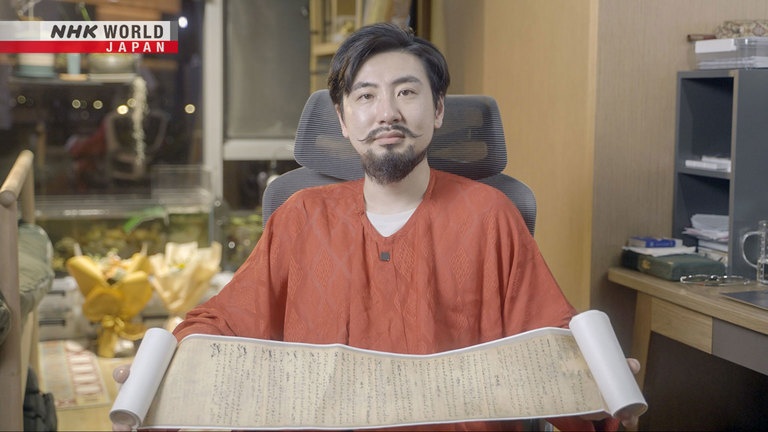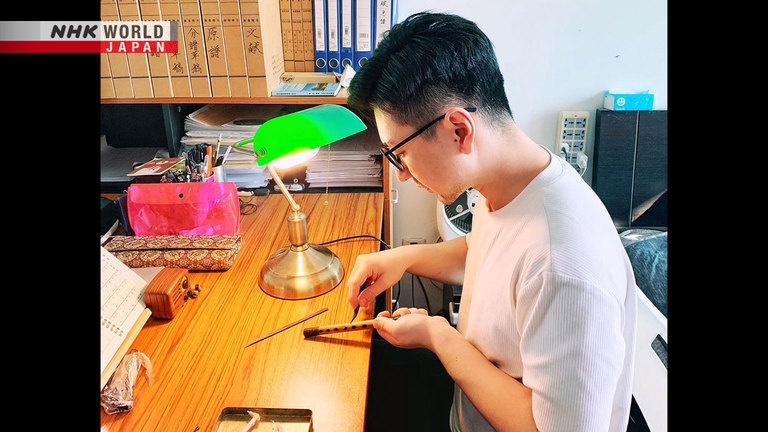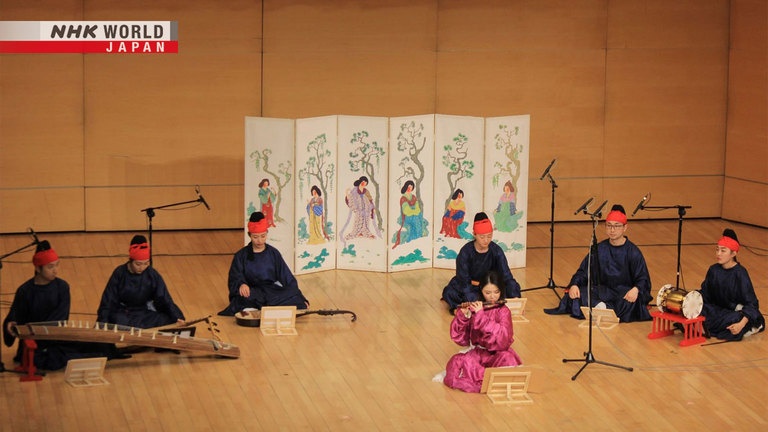A Dream Back to Tang Dynasty: Xu Ge / Founder of the Tang Dynasty Court Music Restoration Organization
The Tang Dynasty Court Music Restoration Organization was founded in 2014 at the initiative of Xu Ge, in 2023, the soundtrack of hit Chinese animation gains attention of the younger generations.




Transcript
Direct Talk
Tang Dynasty music from 1,500 years ago
has re-emerged in China.
The Tang Dynasty Court Music
Restoration Organization
is holding a dress rehearsal.
Keep it confidential.
It's confidential material.
The leader, Xu Ge,
is carrying out final checks.
He's been working to restore
Tang Dynasty music for nearly 10 years.
During that time, he's introduced
many people to Tang Dynasty music,
some of whom went on
to play instruments from the era.
The performance is about to begin.
A Dream Back to Tang Dynasty
Hangzhou, Zhejiang, China
The guests in attendance range
from children to elderly people.
Many are wearing hanfu.
Most of the shows I've seen before
have been purely instrumental.
This time I'll be expecting something different
from the whole stage, especially the choreography.
Prince Qin's Music of Breaking Through the Enemy Array
(Emperor Li Shimin's Triumph Theme)
A famous Tang Dynasty piece that was
originally an Early Tang era military song
The Tang Dynasty Court Music
Restoration Organization was founded in 2014
at the initiative of Xu Ge
and a group of friends
who shared the same values,
they recreated the songs, instruments,
dances, and clothing
that were recorded in ancient texts.
He also released dissertations,
participated in seminars,
and held performances.
In 2019, he released his first album
of ancient Chinese music.
Restored Music Album
He's frequently asked about his motivation.
China's court music culture began
after King Wen and King Wu
established the Zhou Dynasty;
they devised the court music system.
From the emperor to the scholar-officials,
aristocrats used different rites and
music systems based on their social status.
From the Sixteen Kingdoms to the Wei,
Jin, Southern and Northern Dynasties,
nomadic ethnic groups
brought over musical instruments
from Persia and West Asia.
Music preserved from China's ancient periods
intermixed with music
transmitted from foreign countries
and reached a pinnacle.
This music represented
an exquisite blend of cultures.
Dunhuang Murals
During the period when it flourished,
Tang Dynasty music
covered a variety of categories.
From music for rites,
ceremonies, feasts, or military settings,
there was unique music
used for different occasions.
However, little of this music
survived the passage of time.
As a result, Chinese music history is
often referred to as "silent" music history.
Xu Ge is helping Tang Dynasty music
regain its former glory.
Tang Dynasty music was brought into
contemporary society via an unlikely source:
a Japanese envoy on a mission to China
during that time.
Kentoshi (Japanese missions to Tang China)
Tang Expedition Annals Painted Scrolls
In the third year of the Kaicheng Era,
there was an envoy from Japan
called Fujiwara no Sadatoshi.
He went to the commissioner's
residence in Yangzhou,
and asked the 85-year-old pipa master
Lian Chengwu to teach him.
Lian taught him some basic
pipa performance techniques,
which Fujiwara took back to Japan
and recorded.
These are the earliest
surviving pipa music scores in Japan.
The pipa music scores
that Fujiwara brought back to Japan
were passed down
from generation to generation
over the course of more than 1000 years.
Meanwhile, China, after countless wars
and changes in dynasties, welcomed a new era.
In 1989, a boy who would later
bring these scores back to China
was born to a family
that valued traditional culture.
When my father was young,
he got up early to practice music,
so when I was young,
he forced me to practice too.
I played a pretty loud instrument
called suona.
He'd drag me out of bed every morning
before I was fully awake
and have me play by the railroad.
When I didn't want to practice,
he'd say I was trying to slack off.
This continued for about a year
until I got better at playing,
so I was able to practice at home instead.
After attending college, graduate school,
and the Army's literary and art group,
Xu traveled to broaden his perspective.
In 2003, he encountered
Japanese court music: Gagaku.
Ranryo-o (King of Lanling)
Japanese Gagaku
When I first heard Gagaku,
I thought it sounded quite strange.
The timbre is very shrill,
and the melodies of the music are completely
different from those of contemporary music.
When I first listened to it, I found it
to be extremely mournful and haunting.
Later, after more exposure,
I grew to appreciate its unique appeal,
and I slowly started to listen to it
with greater interest and concentration.
Then, I discovered that it shared origins
with ancient Chinese music.
So I set about researching what our own
ancient music might have sounded like,
since we could no longer hear it.
To restore the ancient music,
Xu Ge had to decipher the contents of
ancient texts before they could be performed.
How did he manage to decode the symbols
in these ancient music scores?
Music theory plays an important role,
and Japan and China have lots of books
on Tang Dynasty music theory.
First, we need to understand
what the Tang Dynasty musical keys
and systems were like.
By doing that,
we can verify whether the melodies
recorded in the scores match the theory.
When I got my hands on my first music score,
I couldn't understand it at all.
I read theoretical papers and
painstakingly cross-referenced them
to see what I could make out.
It was very hard work.
These ancient people transcribed music
in a different way than we do now.
Back then, paper was quite expensive,
so the writing was very densely packed.
You have to arrange based on
these tiny marks or symbols.
Different instruments have different scores,
so you have to match up every note.
I toiled away for two years on the first score:
"Wave of Kokonor."
Wave of Kokonor
Tang Dynasty musical score
And these scores don't have just one copy.
The same song may have dozens of versions,
and different instruments also
have scores from different periods.
You basically have to compare
over 100 scores to get just the melody.
Like cracking a code,
there are infinite possibilities,
so you need some sort of manual.
Thankfully, Japan preserved some of the
documents brought back by the envoys,
so we were able to extrapolate from there.
Of course, the things that
the envoys brought back to Japan
didn't represent the entirety
of the Tang Dynasty—
just the small portion that
they came into contact with.
And there were still things that were lost,
or that underwent changes.
It's like a paleontologist trying to get
a complete picture of an extinct organism.
They find a fossilized fragment,
or some pieces of evidence,
then use the scientific method,
studying present-day organisms to infer
what those ancient life forms were like.
It's only through this method
that you can obtain the most likely answer.
I think it's impossible to
fully replicate the Tang Dynasty.
Without the instruments of the time period,
decoding the scores
could only ever remain theoretical,
leaving an incomplete
understanding of the music.
So, Xu Ge began recreating
these ancient instruments.
As he marveled at the craftsmanship
of the Tang Dynasty, his passion grew.
I think restoring instruments is
even more exhausting than restoring scores,
because many of the instruments
from the Tang Dynasty
don't have a continued tradition;
the lineage is broken.
You don't know
what the tone should sound like,
how to make them,
what techniques to use, or what materials.
These very concrete things
are impossible to know for sure.
You have to keep experimenting
over and over again.
I cut this piece of bamboo,
and left it for two or three years,
once the moisture completely
evaporated and it dried out,
I used a craft knife
and carved them out one by one,
boring through each one bit by bit.
One of the holes is even crooked.
Traditionally, the mouthpieces,
were made of reeds.
I've currently switched over to using resin,
a more contemporary material.
Because reeds have fibers,
lots of individual filaments,
they tend to fracture very easily.
Once that happens,
you can't play them anymore.
With resin, basically as long as
you don't use too much force and damage it,
it won't break.
So comparatively,
it has a much longer lifespan.
It was like this in the Tang Dynasty,
according to records:
a piece of bamboo with seven holes
in front and two in the back.
Xu hopes to create more ways
for modern people to come into contact
with ancient music.
For the fifth episode of the
hit animated series "Yao-Chinese Folktales,"
music producer Li Xingyu chose to use
Tang Dynasty music as background music:
a first in the history of Chinese animation.
When I saw the art design for this episode,
my immediate reaction was that
it had a Tang Dynasty vibe.
The color scheme was very reminiscent
of the Tang and Song dynasties,
so it made sense to pair it
with Tang Dynasty music.
The simple and refined feeling of the music
would augment the episode's style and feel.
Help!
Xiao Man, are you all right?
Come on, let's go home quickly.
One important point
is that Tang Dynasty music
has this historical background.
When you understand the history
and the origins of these
instruments and the music,
you'll have the right direction
as you go about using it.
Before this, we always strictly followed
what was recorded in ancient texts
to determine how we should
play these instruments.
But exploring new uses
and methods for these instruments
reveals so much of their latent
and untapped potential.
Doing so means you can synchronize them
with your emotions,
produce more varied and special tones,
and express a greater variety
of feelings and tensions.
I've managed to continue
my work all these years
because of the love
from my fans and supporters.
Thank you, everyone.
In contrast to the modern music
we hear nowadays,
Tang Dynasty music is very relaxing.
It has a kind of ancient beauty...
a kind of... how should I put it,
a kind of beauty
that's very difficult to explain clearly.
Different songs impart different energy.
Even as performers,
we're listening ourselves,
so we also feel very happy and at ease.
Xu remains as passionate
about his work as ever,
his thoughts filled with the restoration
of Tang Dynasty music.
"As long as I live,
Tang Dynasty music will continue."
I hope that while I'm still alive,
as long as I am able,
I can remain on the path
of Tang Dynasty music,
my forward-moving steps never stopping.
Thank you.